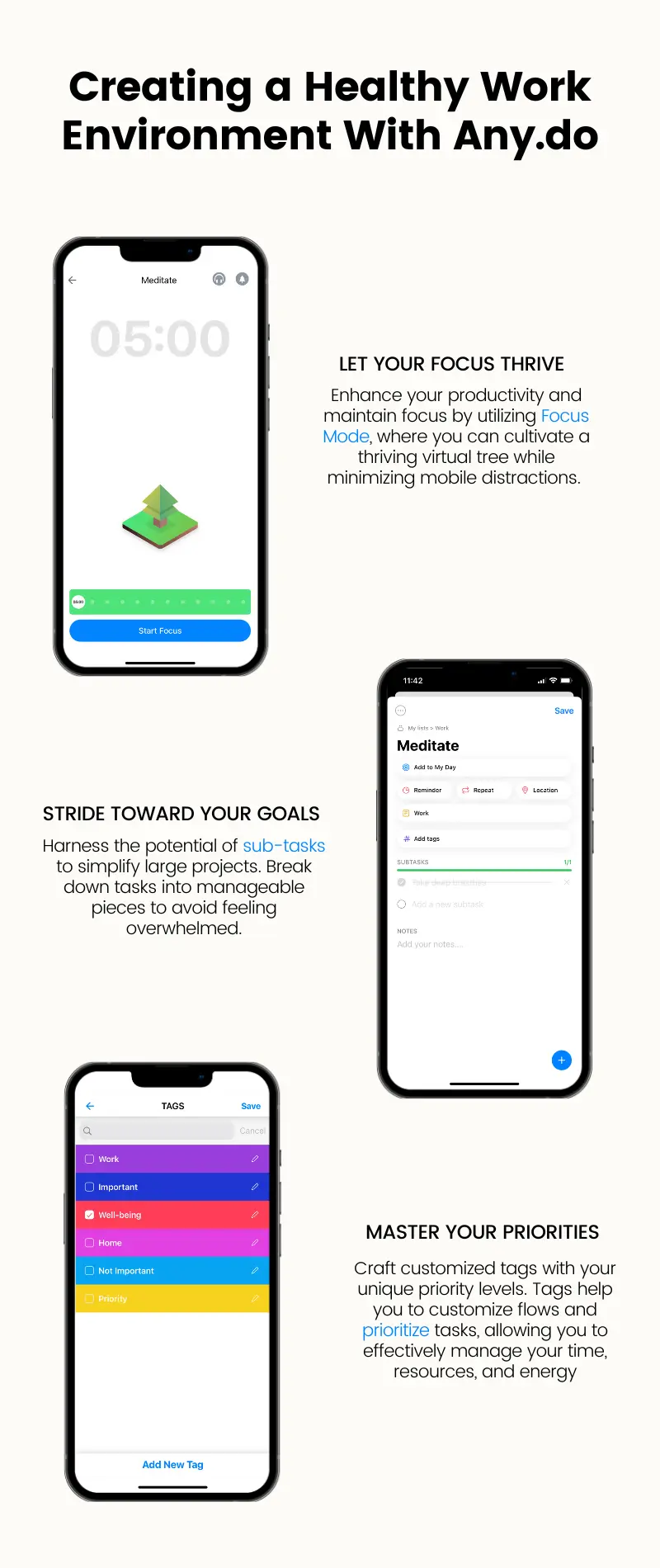A study by the American Psychological Association (APA) found that companies with comprehensive mental health programs reported higher employee engagement and a 33% increase in productivity compared to those without such programs. These findings show the importance of consciously prioritizing our mental health and well-being. Stress , burnout, and poor mental health are pervasive issues that can significantly impact individual performance and the overall dynamics of a team.
In this article, we will explore strategies to enhance well-being and promote mental health in teams and organizations. From stress management techniques to self-care practices, these strategies will empower individuals to prioritize their mental well-being and create a supportive work environment.
Strategies to Prioritize Employee Well-being
Prioritizing mental health and overall well-being is of utmost importance for both managers and employees. When managers prioritize mental health, they foster a supportive and inclusive culture where employees feel valued and understood. This leads to increased productivity, higher job satisfaction, and improved employee retention. Similarly, employees who prioritize their mental well-being can better manage stress, enhance their resilience, and maintain a healthy work-life balance. Taking care of mental health not only benefits individuals but also creates a positive and thriving workplace where everyone can thrive, collaborate effectively, and achieve their full potential.
1. Recognize the Importance of Well-being and Provide Support in the Workplace
Recognize the importance of mental well-being for optimal productivity and overall success. Encourage open conversations about mental health to reduce stigma and foster a culture of support and understanding.
Create a supportive work environment that values mental health and well-being. Promote a culture where individuals feel comfortable seeking help or sharing their struggles without fear of judgment. Establish employee assistance programs or resources for mental health support and provide training to managers on recognizing signs of distress and offering appropriate support.When individuals and teams prioritize mental well-being, they are better equipped to handle challenges, adapt to change, and perform at their best.
2. Promote Work-Life Balance
Promote a healthy work-life balance to prevent burnout and prioritize well-being. Set clear expectations around working hours and overtime, and discourage a culture of constant availability. Within the workday promote the importance of regular breaks by encouraging individuals to step away from their workstations during breaks, engage in activities they enjoy, or simply relax. Additionally, support employees in utilizing their vacation days.
Regularly monitor the workload of team members and ensure that it is manageable. If someone is overwhelmed, offer support and resources to help them effectively manage their tasks. Distribute workload evenly among team members and encourage collaboration to support a healthy work-life balance.
Supporting employees in finding work-life balance can make a significant difference in preventing burnout and enhancing overall mental well-being. By promoting work-life balance, individuals can recharge and maintain mental health, leading to increased productivity and job satisfaction.
3. Empower Resilience
Equip individuals with practical stress management techniques to confidently navigate workplace pressures. Encourage regular breaks, mindfulness exercises, and deep breathing techniques as effective tools for reducing stress levels. Promote the importance of physical activity, such as walking or stretching breaks, to release tension and boost mood. Emphasize the significance of utilizing vacation days and encourage employees to take time off when needed. Provide valuable resources and engaging workshops focused on stress management, resilience, and mindfulness practices, empowering individuals to develop healthy coping mechanisms and enhance their mental well-being.
These opportunities allow individuals to develop healthy coping mechanisms and enhance their mental well-being. Recognize that self-care is not selfish but a vital aspect of maintaining mental health and overall productivity.
4. Foster Positive Relationships
Emphasize the importance of positive relationships in the workplace. Encourage collaboration, teamwork, and mutual respect among team members by fostering a supportive and inclusive culture that values diversity and promotes healthy working relationships. Building positive social connections not only fosters a sense of belonging but also enhances job satisfaction and promotes mental well-being.
5. Nurture Holistic Well-being with Company Resources and Education
Implement employee wellness programs that focus on holistic well-being, including mental health. These policies can include flexible work arrangements, mental health training for managers, and access to mental health resources. This can include workshops on stress management, building resilience, and recognizing signs of mental health concerns or wellness challenges and access to fitness classes. Offer resources or workshops on mindfulness techniques and provide quiet spaces where employees can engage in meditation or relaxation exercises. Additionally, provide access to counseling services, mental health hotlines, or online platforms that offer support and information.
By increasing mental health literacy within the organization, employees and managers are better equipped to support each other and seek help when needed. Formalizing these policies and programs also helps organizations demonstrate a commitment to supporting the mental well-being of their employees.
6. Lead by Example To Encourage Well-Being
Leaders play a critical role in promoting mental well-being within teams and organizations. Lead by example by prioritizing your own mental health and openly discussing its importance. Encourage self-care practices, work-life balance, and open dialogue about mental health. By modeling these behaviors, leaders inspire their teams to prioritize mental well-being and create a culture of well-being and productivity.
7. Foster a Culture of Feedback and Open Communication
Create a culture that values feedback and recognition to support mental health. Regularly provide constructive feedback and recognition for a job well done. Promote open communication throughout the organization, creating an environment where individuals feel safe to discuss their mental health concerns. Encourage managers to have regular check-ins with their team members to provide support and address any issues.
When individuals experience recognition, appreciation, and value for their efforts, it has a profound impact on morale and contributes to improved mental well-being. This sense of acknowledgment fosters a feeling of personal significance and belonging within the organization. Moreover, by fostering open communication, organizations can actively dismantle stigma, creating a culture where individuals feel comfortable reaching out for help and support, ultimately nurturing an environment that promotes mental well-being.
8. Foster Social Connections and Team Bonding
Encourage social connections and team bonding activities to promote a sense of belonging and camaraderie. Organize team-building events, virtual hangouts, or social activities that allow team members to connect on a personal level. These connections contribute to a positive work environment and enhance mental well-being by reducing feelings of isolation and fostering a supportive network.
9. Support Employee Self-Development
Support employees’ self-development by providing opportunities for growth and learning. Offer training programs, workshops, or educational resources that allow individuals to enhance their skills and knowledge. This can also be done by offering flexibility and autonomy in work arrangements whenever possible. Providing individuals with control over their work schedules and autonomy in decision-making. Supporting employees’ personal and professional growth contributes to their overall well-being and sense of fulfillment and allows them control over their priorities.
Leveraging Any.do to Boost Employee Morale and Well-Being
Any.do can play a significant role in improving organizational well-being and mental health among employees. Here are some ways Any.do can help:
- Reduce Mental Overwhelm: With Any.do, employees can prioritize their tasks and focus on what truly matters using focus mode. This promotes a sense of clarity, reduces overwhelm, and enhances productivity, leading to a healthier work-life balance.
- Stress Reduction and Mindfulness: Any.do’s features, such as reminders, notifications, tags to help prioritize tasks, and the ability to break tasks into sub-tasks, help employees stay organized and reduce stress. Additionally, integrating mindfulness practices into daily routines, such as setting aside time for reflection and self-care, can contribute to improved mental health.
- Work-Life Balance: Any.do encourages individuals to maintain a healthy work-life balance by setting boundaries, managing tasks efficiently, and providing flexibility in managing personal and professional responsibilities. This promotes well-being by allowing employees to recharge, spend quality time with loved ones, and engage in activities outside of work.
By utilizing Any.do’s features and incorporating it into organizational practices, companies can support their employees’ mental health and well-being, leading to increased engagement, satisfaction, and overall productivity.
Prioritizing Mental Health: A Customized Approach for Lasting Well-being
Improving mental health and overall well-being is mutually beneficial for both companies and individuals. By implementing these strategies companies can foster a supportive environment that prioritizes mental well-being which has numerous benefits for teams and organizations alike.
Recognize that mental health is unique to each individual, and what may be effective for one organization or individual may not necessarily work for another. It’s important to remain open to different strategies and approaches and seek feedback from employees. By actively listening and involving employees in the process, organizations can gain valuable insights and tailor their approaches to better meet the specific needs of their workforce.



